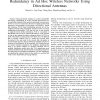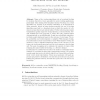149 search results - page 21 / 30 » PEER: a progressive energy efficient routing protocol for wi... |
MOBIHOC
2002
ACM
14 years 7 months ago
2002
ACM
Network wide broadcasting in Mobile Ad Hoc Networks provides important control and route establishment functionality for a number of unicast and multicast protocols. Considering i...
WCNC
2008
IEEE
14 years 1 months ago
2008
IEEE
—Using directional antennas to conserve bandwidth and energy consumption in ad hoc wireless networks has attracted much attention of the research community in recent years. Howev...
GLOBECOM
2007
IEEE
14 years 1 months ago
2007
IEEE
— An opportunistic large array (OLA) is a form of cooperative diversity in which a large group of simple, inexpensive relays or forwarding nodes operate without any mutual coordi...
ADHOCNOW
2004
Springer
14 years 24 days ago
2004
Springer
Many ad hoc routing algorithms rely on broadcast flooding for location discovery or more generally for secure routing applications, particularly when dealing with Byzantine threat...
TMC
2002
13 years 7 months ago
2002
We consider ad hoc wireless networks that use directional antennas and have limited energy resources. To explore quantitatively the advantage offered by the use of directional ante...


